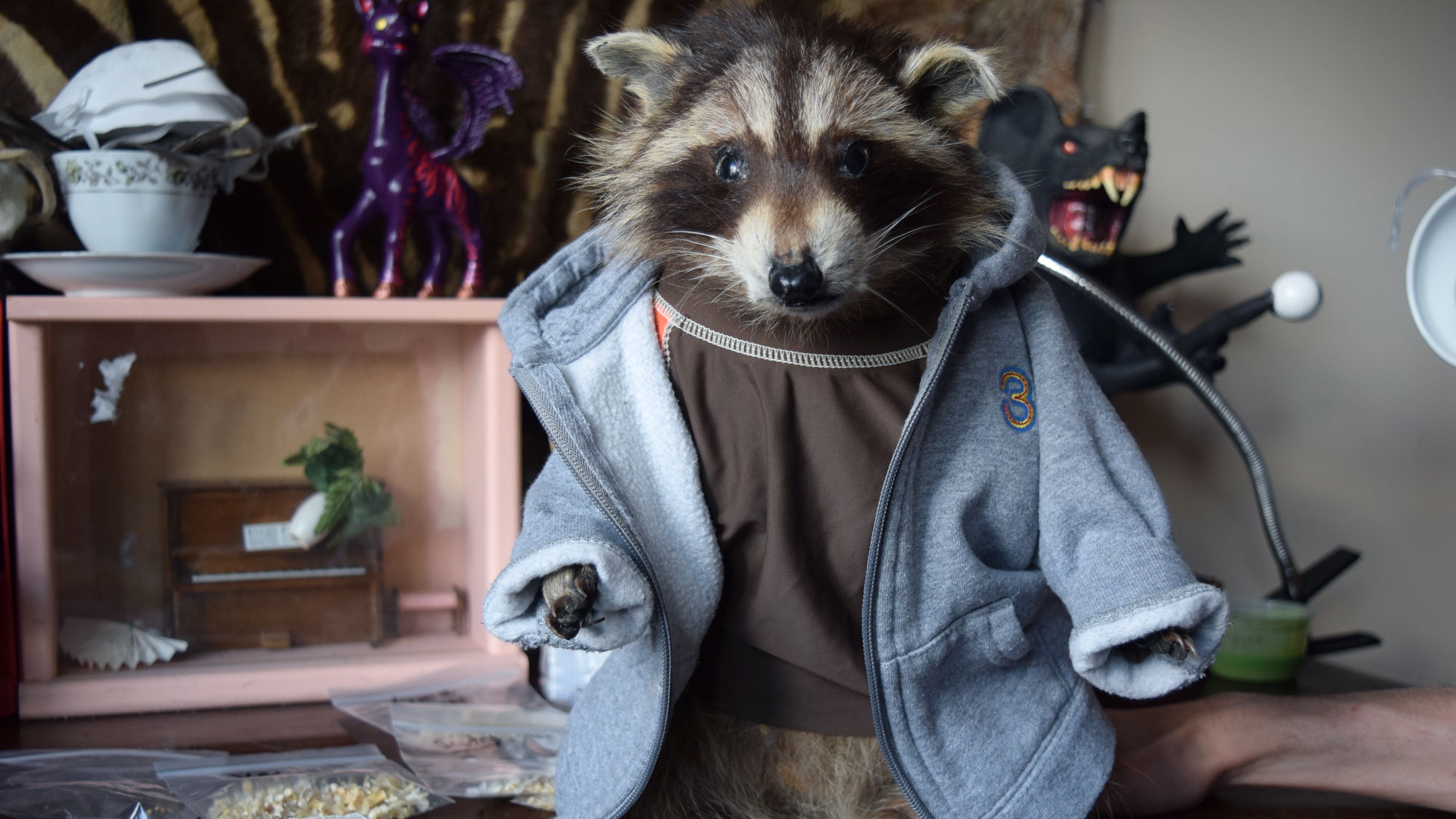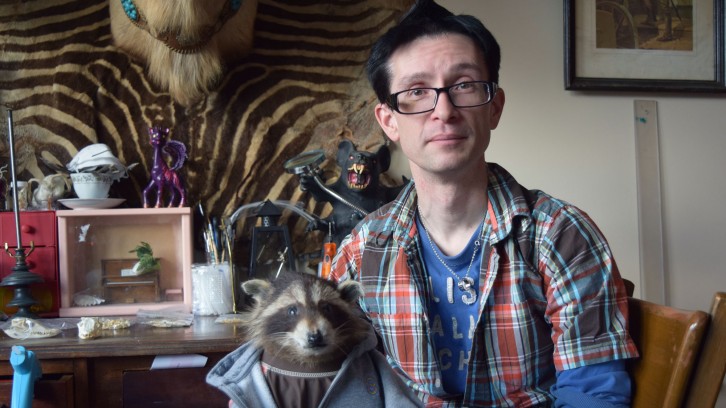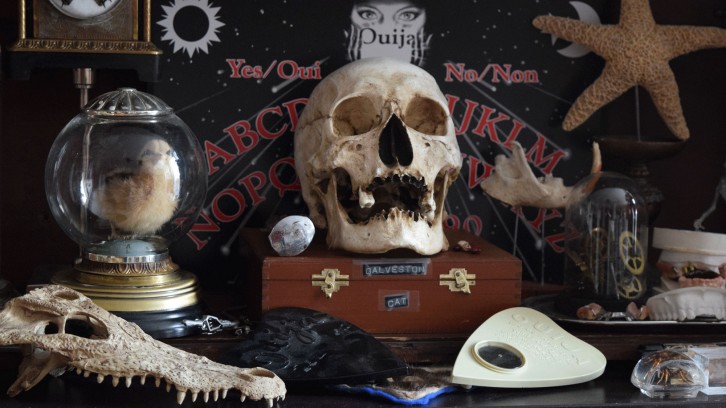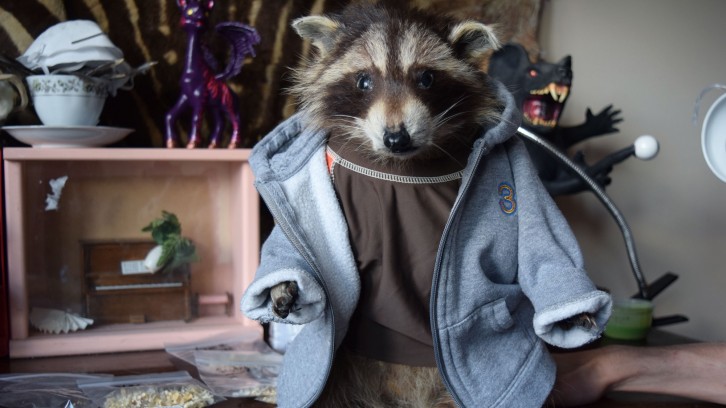Taxidermy
Self-taught taxidermist earning a following
Halifax man spends his spare time making art with dead animals

caption
This raccoon, named Derpy, is one of Hillman's many creatures that he dressed up in outfits.
caption
Doug Hillman does taxidermy in his apartment in Halifax.A few weeks ago, Doug Hillman spotted a dead crow on his way to Walmart.
He took a quick look around, then wrapped up the bird and brought it home.
Now, the crow is sitting in his fridge.
“There’s him, there’s a chipmunk in there, I think, a couple of snakes, and the body of a bunny rabbit.”
Those animals will soon be cut apart and made into art. Hillman is a self-taught amateur taxidermist.
Walk into his small bachelor apartment, and you enter into a land of oddities. The entire space is filled with dozens of mounted animals and reconstructed skeletons. Posters from old horror movies add to the ambience.

caption
Hillman’s apartment is filled with decorations like these.It all started with a rat. About five years ago, Hillman came across a YouTube video of someone “taxidermying up a mouse.” He was surprised by how simple it looked, so he decided to give it a try. He headed to a pet store and bought a frozen dead rat that would have been fed to a snake.
“It was just a spur of the moment thing I thought would last five minutes, and that would be it,” said Hillman.
He followed the instructions and skinned the rat, flattening it out “like a bear skin rug.”
He was happy with how it turned out. So, he bought another rat. Then a few more. He was hooked.
Soon, he was able to mount the rats. That’s when you stuff them and return them to the form of the animal.
“Then I’m like, what am I going to do with all these rats?”
At the suggestion of a friend, he decided to dress them up and try selling them.
He dressed up a guinea pig to look like a Victorian era judge – complete with a top hat and monocle. He had rats dressed as a police officer and lawyers. He posted them on Kijiji, and within 25 minutes he heard from a woman who wanted to buy them all. He says he sold the set for about $400.
“It floored me, absolutely floored me,” said Hillman. “I was shocked, so I went home and I thought, ‘well what can I do now?’”
With rats dressed like Sherlock Holmes and Watson, and Frankenstein and the monster, and a raccoon dressed in steampunk, Hillman gets creative.

caption
This raccoon, named Derpy, is one of Hillman’s many creatures that he dressed up in outfits.This kind of taxidermy – where creative liberty is taken with the animals– is sometimes referred to as rogue taxidermy. Hillman’s creative pieces have become pretty popular.
He started an Instagram page, which now has more than 5,000 followers. He also sells some of his work at Plan B Merchants Co-op. He has pieces that sell for up to $1,000.
Next month, Hillman will teach an introduction to taxidermy class at Plan B. The eight spots for the one-day class filled up so quickly that he decided to add a second class.
A learning curve
Hillman says if you plan well, you can do taxidermy fairly cheaply. He gets most of his supplies from the grocery store.
And over the last few years, he’s come up with some tricks.
When mounting an animal, a taxidermist makes a mould, usually out of foam, which they then cover with the animal skin. Hillman says for a large animal, the foam could cost hundreds of dollars.
He realized one day that he could use tinfoil and wire to make cheap, lightweight moulds.
And after he skins an animal, he doesn’t ditch the insides. He also reconstructs skeletons.
[idealimageslider id=”11498″]
Hillman separates his animals into pieces at the joints, a process he compares to stripping down a chicken.
Then, in a small camping stove by an open window he boils the bones to get the last of the meat off. Finally, he cleans the bones by hand, puts them into peroxide to whiten them, then degreases them in dishwashing detergent for about a week.
Hillman sometimes saves the organs as well. He’ll preserve organs in jars filled with alcohol.
“A lot of people like the oddity of it. That’s what they want.”
[idealimageslider id=”11494″]
An engrossing hobby
Taxidermy is Hillman’s hobby, but he says he has to force himself to only work on his projects a few days a week.
“I mean otherwise I’d never leave this apartment,” says Hillman. “Sometimes you get so engrossed into it – and I’ve done it – where I didn’t see the outside for like a week. And it’s like, OK, enough dead animals here, I’m getting outside.”
Hillman doesn’t tell everyone about his hobby. He says his neighbours have no idea what goes on inside his apartment.
He says his friends and family think his hobby is odd, but they respect it.
“They think I’m weird. I mean, yeah of course they think I’m weird,” said Hillman. “But it’s more like a playful kind of thing.”
Hillman has had practice coming face to face with death. He worked for a few years as an apprentice embalmer and funeral director in a funeral home.
Hillman says despite what some people think, he isn’t obsessed with death and gore.
He says he hasn’t killed any of the animals he’s worked with. About 80 per cent are road kill, and 10 per cent are people’s pets that have died from natural causes. The last 10 per cent fall somewhere in between, like rats or rabbits that would have been used as snake feed.
He says when he looks at a skeleton, he doesn’t think about death.
“For me it’s a work of art that nature can give us.”
